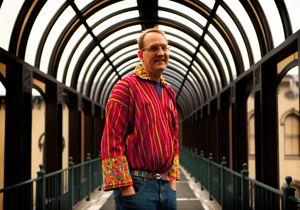by Jason Lee Miller
photos by Mark Cornelison
Academic roads can lead to some interesting places. Rusty Barrett, an expert in sociolinguistics and professor in the University of Kentucky’s College of Arts and Sciences, perhaps never dreamed when he began studying Russian and Soviet culture in the 1980s that he would one day wander covered in mud through the Guatemalan wilderness in search of a Maya village.
He probably couldn’t have fathomed that he would rent an adobe house for six dollars per month, that he would knock out the village’s power every time he took a shower, that he would find "Kentucky" brand basketballs sold at the local market.
 Along an earlier road far from Guatemala, Barrett worked for the American Institute of Aeronautics and Astronautics, where he translated Russian space program documents. Later, he would decipher Croatian, Bulgarian, and other Slavic languages upon request. His skill at deciphering languages and his versatility in linguistics eventually led him to studying Mayan hieroglyphs, and ultimately, to UK, one of three universities in the United States offering academic study in K’iche’, the most widely spoken Mayan language in Guatemala.
Along an earlier road far from Guatemala, Barrett worked for the American Institute of Aeronautics and Astronautics, where he translated Russian space program documents. Later, he would decipher Croatian, Bulgarian, and other Slavic languages upon request. His skill at deciphering languages and his versatility in linguistics eventually led him to studying Mayan hieroglyphs, and ultimately, to UK, one of three universities in the United States offering academic study in K’iche’, the most widely spoken Mayan language in Guatemala.
Barrett’s interest in obscure languages aligns with a greater cause in the study of linguistics: the preservation and revival of languages and cultures on the brink of extinction. “In 100 years, 90 percent of the world’s languages will be gone,” he warned.
Among Barrett’s chief concerns is that K’iche’, currently spoken by about a million Maya, could be one of them. It’s easy to see how that could happen; modern day Maya vacillate between their native tongues and Spanish, and, to an extent, English. Among the many Maya migrant workers in the States, English joins Spanish to supplant the 28 separate Mayan languages that still exist. About a million people still speak K’iche’, but far fewer speak other Mayan languages like Sipakapense and Uspanteko. In Guatemala alone, there are 22 Mayan languages—not dialects, he clarifies, but languages, like French and Italian.
Through UK, Barrett works to preserve the Mayan languages in communities that suffered greatly during a civil war in the 1980s. “Civil war” might be a “civil” term—the Maya were subjected to genocide, and about 200,000 were killed. Barrett says an underground railroad leading as far away as Canada helped many to escape. In some villages, more Maya left than stayed.
Once the war ended, a Maya Renaissance was born, and scholars like Barrett began work to help the Maya reclaim their heritage in the aftermath of the war. Last fall, for example, he taught a course in K’iche’, and arranged for a native speaker to make regular visits to UK’s campus.
Greg Stump, director of UK’s Linguistics Program, boasted UK “is just tremendously lucky” to have “an exceptionally versatile linguist” like Barrett on faculty. And when he says “versatile,” Stump isn’t just whistling Dixie, as they say. Barrett’s specialties go beyond Russian or preservation of modern day Mayan. His pioneering sociolinguistic research also includes topics as diverse as Spanish-speaking restaurant workers, football players’ trash talk and drag queens.
“Since joining our faculty, he has also been exceptionally energetic in the classroom,” said Stump. “He has designed and taught a range of new courses, including courses on language discrimination, African-American English, language endangerment, and language and sexuality.”
 Barrett describes sociolinguistics as the study of how relationships are forged and negotiated through language, and this can include understanding the intricate nuances of subsets and dialects of widely used in languages like English. “Kentucky is a great place for sociolinguistics,” said Barrett.
Barrett describes sociolinguistics as the study of how relationships are forged and negotiated through language, and this can include understanding the intricate nuances of subsets and dialects of widely used in languages like English. “Kentucky is a great place for sociolinguistics,” said Barrett.
Because of the state’s unique positioning—sort of between North and South, between Appalachia and Midwest— a variety of accents and dialects coexist. In addition to Appalachian dialects, which may be the quickest to come to mind, people from northern Kentucky often exhibit speech similar to southern Ohioans; in western Kentucky, the people may sound more like the people in Tennessee. “It’s an interesting place to teach,” he said.
It also seems like an unlikely place to learn about Maya culture, situated so far away from Central America. But there is a sizeable Maya population in Kentucky, primarily Mam, but the Maya are also familiar with UK because of the work linguists like Barrett have done to preserve Mayan languages—that, and they’re big basketball fans. “Basketball is huge among the Maya,” he said.
So in that sense, something like a sport becomes a common bridge, a sort of unspoken language, between cultures. The language of hip-hop, a sociolinguistic phenomenon Barrett will be exploring with students next fall, works similarly as a cultural bridge. Though English is becoming the world’s dominant language, it has surprising help from hip-hop, which is popular throughout the world, especially among minority groups and marginalized cultures. You may be surprised to learn of such a thing as Maya hip-hop, as well as Hopi, Navajo and Australian Aboriginal hip-hop. There’s even a French Canadian variety.
Hip-hop has emerged as an organic language/methodology used to preserve cultures considered to be outside of the mainstream. “[In hip-hop], it’s important to emphasize local identity,” said Barrett. “Minority groups and marginalized people latch on as a political statement.”
The Linguistics program at UK, then, provides a nice incubator for Barrett’s current academic raison d’etre: the desire to understand the various languages of the oppressed and ostracized, and how language can both unify and divide cultures.
